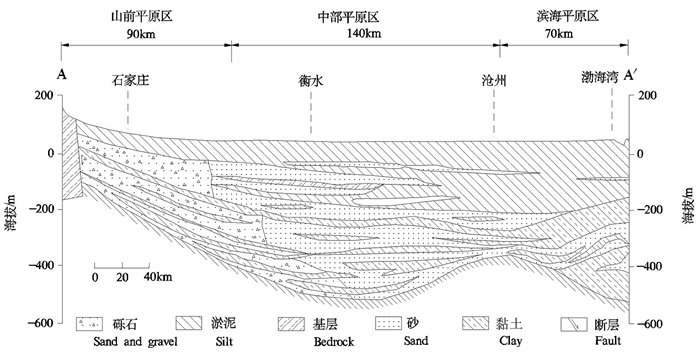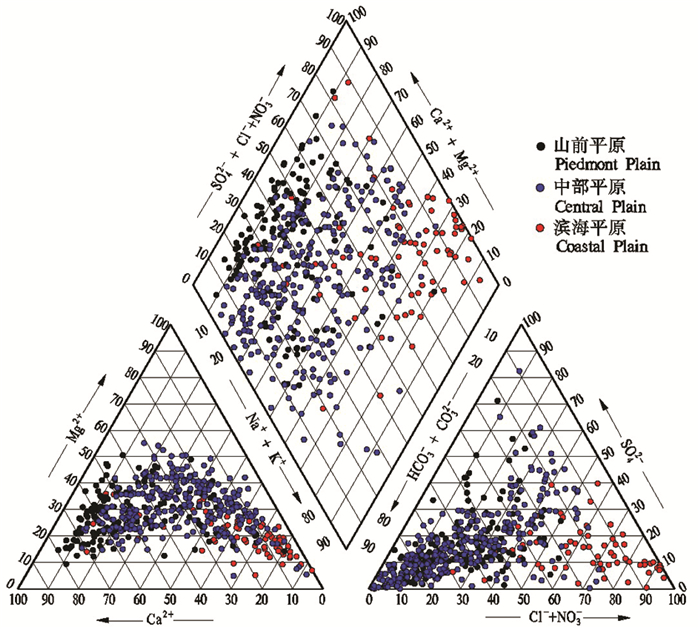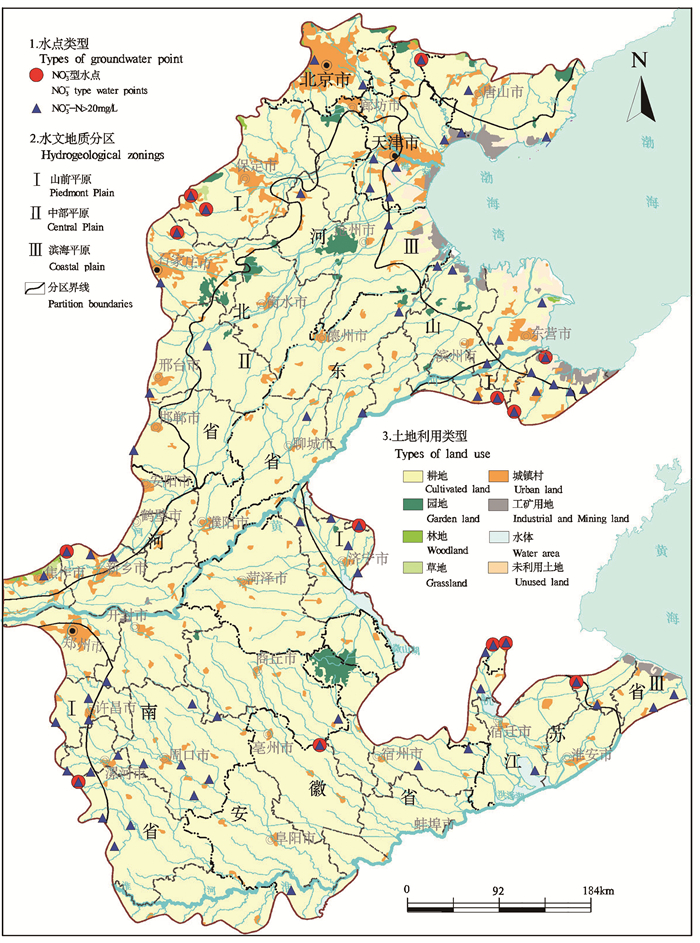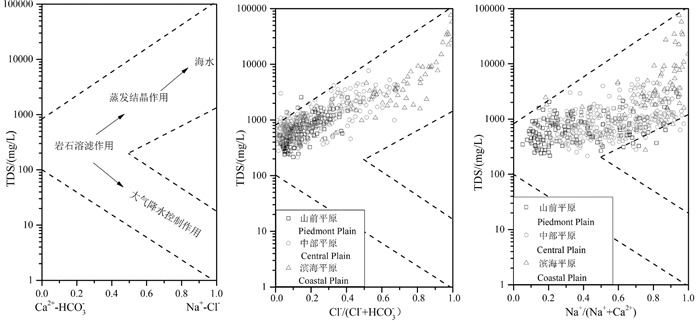Characteristics and driving mechanisms of evolution of groundwater chemistry in Huang-Huai-Hai Plain and its exploitation and utilization suggestions
-
摘要:研究目的
地下水是保障黄淮海平原生产、生活所需的主要水资源之一。在人类活动的影响下,地下水环境恶化已成为制约社会经济发展和生态平衡的重要因素。深入探究地下水化学演化特征及其形成机制,可为地下水资源的合理开发利用提供重要参考依据。
研究方法本文将黄淮海平原分为山前平原、中部平原、滨海平原三个水文地质单元,综合运用Piper三线图、Gibbs图、主成分分析等方法,研究了中国黄淮海平原的地下水化学特征及其形成机制。
研究结果结果显示,从山前平原到中部平原再到滨海平原地下水中TDS含量逐渐升高,由淡水逐渐演化为微咸水、咸水、盐水、卤水;研究区地下水化学类型从山前平原的44种增至中部平原的74种,而后下降至滨海平原的22种;其中,山前平原地下水化学类型以HCO3-Ca·Mg、CO3-Ca为主,主要受控于一个4因素模式,相比之下,中部平原和滨海平原地下水化学则分别受控于3因素模式。
结论黄淮海平原地下水化学特征呈明显分带性,从山前平原到中部平原到滨海平原地下水化学类型由CO3型逐渐演化为CO3·SO4型、CO3·Cl型、SO4型、SO4·Cl型,最终演化为Cl型水。研究区地下水化学在空间尺度上主要受控于多种自然因素(岩石风化、蒸发浓缩和阳离子交替吸附、海水入侵),其在时间尺度上明显受多种人类活动(地下水超采、土地利用变化、生活污水、化肥、动物粪便)的影响。针对山前平原至滨海平原各区不同的地下水化学特征及其人类活动影响,有针对性地提出了黄淮海平原地下水资源开发利用方面的管控建议。
创新点:(1)分析了山前平原、中部平原、滨海平原地下水化学特征,并讨论了这三个平原区地下水化学演化的自然因素;(2)黄淮海平原地下水化学特征呈明显分带性,从山前平原到中部平原到滨海平原地下水化学类型由HCO3型逐渐演化为HCO3·SO4型、HCO3·Cl型、SO4型、SO4·Cl 型,最终演化为Cl型水,并探讨了黄淮海平原地下水化学演化的主控因素。
Abstract:This paper is the result of hydrogeological survy engineering.
ObjectiveGroundwater is one of the major water resources to supply water for the production and daily life of human activities in the Huang-Huai-Hai Plain (HP). The deterioration of groundwater environment has become an important factor restricting social and economic development and ecological balance at the conditions of human activities. Understanding the characteristics and driving mechanisms of evolution of groundwater chemistry can provide an important reference for the rational development and utilization of groundwater resources.
MethodsIn this paper, the HP is divided into three hydrogeological units including piedmont plain, central plain, and coastal plain. The characteristics and driving mechanisms of evolution of groundwater chemistry in HP in China are studied by using Piper diagram, Gibbs diagram, and principal component analysis.
ResultsResults showed that TDS concentrations in groundwater increased gradually from piedmont plain to coastal plain, and groundwater was evolved from freshwater to brine via brackish water and salt water. Groundwater in the study area was from 44 hydrochemical facies in the piedmont plain increased to 74 hydrochemical facies in the central plain, and then decreased to 22 hydrochemical facies in the coastal plain. Among them, the hydrochemical facies of groundwater in the piedmont plain were dominated by CO3-Ca · Mg and CO3-Ca, and was mainly controlled by a 4-factors model, by contrast, groundwater chemistry in the central and coastal plains was controlled by two 3-factors models, respectively.
ConclusionsThe chemical characteristics of groundwater in the HP are obviously zonal, and the hydrochemical facies of groundwater from the piedmont plain to the coastal plain was evolved gradually from CO3 facies to CO3 · SO4 facies, CO3 · Cl facies, SO4 facies, as well as SO4 · Cl facies, and finally convert to Cl facies. The groundwater chemistry in the study area is mainly controlled by a variety of natural factors such as rock weathering, evaporative concentration, cation alternate adsorption, and seawater intrusion on the spatial aspect, and is obviously affected by various human activities (e.g., groundwater overexploitation, land use change, domestic sewage, fertilizers, and animal manure) on the time aspect. According to the different chemical characteristics of groundwater and the impact of human activities in the areas from piedmont plain to coastal plain, the management and control suggestions on the development and utilization of groundwater resources in the HP are put forward.
-
1. 引言
地下水是保障生产、生活需要不可缺少的重要资源,特别是在地表水资源匮乏的地区(陈宗宇等,2010;Carol et al.,2013)。地下水也是影响生态环境的重要生态因子,深入探究地下水化学演化特征和形成机制,对地下水资源的可持续利用和生态健康发展具有重要意义。
地下水化学演变受控因素众多,大致可分为自然因素(如水文地质条件、岩性,水岩作用、海水入侵、气候)和人为因素(如城市化发展、地下水超采、土地利用)两大类(孙厚云等,2018),近年来,国内外学者在此方面均有相关研究报道。如Borzi et al.(2019)利用同位素研究了Samborombón河流域控制地下水和地表水自然成分的机制,认为促进地表水和地下水演化的地球化学过程与雨水渗透、碳酸盐溶解、阳离子交换和蒸发有关;Dalila et al.(2016)利用水化学方法和多元统计技术,探讨阿尔及利亚东部Ain Djacer Mio Plio第四纪含水层地下水化学演化的主要控制因素和形成机制,认为第一个主控因素是盐碱化,第二个主控因素与化肥有关;Li et al.(2018)运用Gibbs图及反向地下水化学模拟等方法研究了松嫩平原东部浅层地下水化学特征及形成机制,认为地下水化学成分受地形地貌因素和地下水赋存条件的控制,岩石风化溶解是拉林—阿什河地下水分区主控因素,蒸发和离子交换作用在呼兰—铜肯河地下水分区更为明显,地下水超采导致了局部异常的水化学演化过程;章光新等(2006)综合运用描述性统计、相关性分析、离子比例系数等方法分析了东北松嫩平原地下水化学特征与演变规律,认为风化溶滤、蒸发浓缩、阳离子交换和人为混合是控制地下水质演变的主要水文化学过程;Huang et al.(2018)借助主成分等多元统计方法研究了珠江三角洲地区各含水层地下水水化学控制因素,认为海水入侵、水岩相互作用等自然因素和工业化、农业污染等人为活动是珠江三角洲地区地下水化学演化的两大主要因素。探讨地下水化学演化的总体趋势,科学认识自然因素和人为因素对地下水环境的影响,合理解释不同地下水化学特征,是地下水化学演化研究的趋势。
黄淮海平原是中国三大平原之一,是中国经济、文化的中心地带,是重要的工农业生产基地。地下水是支持黄淮海平原经济发展,保障供水的重要水源。随着城镇化、工业化进程的加快,地下水资源的不合理开发利用已引起了一系列生态环境问题,如地面沉降和地裂缝(李世雄等,2006)、湿地退化(乔光建等,2010)、地下水质恶化(费宇红等,2009)、海水入侵(姜体胜等,2010;李文鹏等,2020),因此了解地下水化学特征及其形成机制对该区的地下水资源合理开发利用具有重要参考意义。
黄淮海平原是一个独立的地下水流系统,由于地下水资源处于持续开发状态,且受自然条件与人类活动的双重作用,因此,对黄淮海平原进行分区,研究地下水化学时空变化特征,是水资源科学开发利用的重点(滕彦国等,2010)。本次研究将黄淮海平原分山前平原、中部平原、滨海平原三个水文地质单元,分别探讨不同水文地质单元的地下水化学特征;基于Gibbs、主成分分析等方法讨论不同水文地质单元地下水化学演化的主控因素。研究结果可为探究黄淮海平原地下水水循环机制、制定合理有效的地下水开发利用方案和环境保护措施等方面提供基础依据。
2. 研究区概况
2.1 地理条件
黄淮海平原位于中国东部,总面积32万km2,约占全国平原总面积的三分之一。位于113°05′~120°40′E,33°54′~40°48′N。北起燕山南麓,南达大别山北侧,西倚太行山—伏牛山,呈簸箕状向东倾向于渤海和黄海,包括五省二市,即河北省、山东省、河南省、安徽省、江苏省和北京市、天津市。该区年均气温为11~15℃,南部地区年均温度略高于北部,年降水量自东南向西北逐渐减少,一般年降水量为400~1100 mm,主要集中在7—9月。冬季寒冷干燥,夏季高温多雨,春季干旱少雨,蒸发强烈,在气候条件的影响下,水资源比较紧缺。研究区内工农业发达,人口密集,伴随城市化规模的不断扩大,水资源的需求与日俱增,已成为中国严重缺水的地区之一。
2.2 地质和水文地质条件
黄淮海平原是一个完整的地下水流系统。山前一带为洪积冲积,平原中部为湖积冲积或冲积湖积,滨海一带为湖积冲积并有海积(张宗祜等,1997;乔晓辉等,2013)。区域分带性特征决定了地下水含水层补给、径流、排泄条件,以及地下水化学等方面的差异,故将研究区划分为3个大的水文地质单元,即山前冲洪积倾斜平原区(简称山前平原),黄河、海河冲积平原区(简称中部平原),滨海冲积海积平原区(简称滨海平原),分区见图 1。研究区地下水资源主要分布在第四系含水层。山前平原颗粒粗,以卵砾石、中粗砂为主,垂向连续性强,属于单层或双层结构,具有强入渗补给和储存条件,60%以上的地下淡水资源储存于此。中部平原岩性逐渐变细,以细砂粉砂为主,含水层属多层结构(图 2,图 3)。滨海平原水位埋深较深,有明显隔水层。地下水化学类型在未大规模开采前有明显的规律性:山前平原以HCO3型水为主,中部平原以SO4、Cl、HCO3混合型水为主,滨海平原则以Cl及Cl-SO4型水为主(张宗祜等,1997)。经长时间大规模开采后,浅层地下水化学特征趋于复杂,尤其是中部平原,由早期的HCO3-SO4、Cl-SO4、SO4-Cl混合型水演化为HCO3-SO4、HCO3-Cl、Cl-SO4、SO4-Cl、SO4、Cl-SO4、SO4-Cl等混合型水,潜水Cl及Cl-SO4型水分布面积大大减小,地下水趋于淡化(张兆吉等,2009)。
![]() 图 2 石家庄—渤海湾水文地质剖面图(A-A'剖面)(据张宗祜和李烈荣,2004)Figure 2. The hydrogeological profile along the Shijiazhuang-Bohai Bay (after Zhang Zonghu and Li Lieying, 2004)
图 2 石家庄—渤海湾水文地质剖面图(A-A'剖面)(据张宗祜和李烈荣,2004)Figure 2. The hydrogeological profile along the Shijiazhuang-Bohai Bay (after Zhang Zonghu and Li Lieying, 2004)![]() 图 3 驻马店—黄海水文地质剖面图(B-B'剖面)(据国家地质总局水文地质工程地质研究所,1979)Figure 3. The hydrogeological profile along the Zhumadian-Yellow Sea (after Institute of Hydrogeology and Engineering Geology, State General Administration of Geology, 1979)
图 3 驻马店—黄海水文地质剖面图(B-B'剖面)(据国家地质总局水文地质工程地质研究所,1979)Figure 3. The hydrogeological profile along the Zhumadian-Yellow Sea (after Institute of Hydrogeology and Engineering Geology, State General Administration of Geology, 1979)研究区地下水流向总趋势是从山前平原流向滨海平原。补径排条件由西向东逐渐变差,山前地带补径排条件极好,富水性在洪冲积扇为极强至强,在洪冲积扇下部及山间地带大多为中强,主要接受侧向径流、大气降水、灌溉回归水渗入及河流侧向渗入补给,主要的排泄方式为侧向径流及人工开采。南部平原水位埋深浅,潜水蒸发量相当大。
2.3 地下水资源开发利用状况及其资源环境效应
随着城镇化、工业化进程的加快,大量农村人口不断涌入城市,工业和生活废污水年排放量呈增长趋势,污水处理设施建设落后于城镇化的快速发展,特别是在城市周边地区,已引起地下水中有毒有害物质增多,特别是硝酸盐超标严重(李政红等,2005)。用水量的增加已引起部分地区地下水超采严重,形成地下水降落漏斗(王晓光等,2019),引发一系列的环境地质问题。如地面沉降和地裂缝、湿地退化、地下水硬度增加,滨海平原区地下水超采导致地下水水位低于海平面,水力坡度向内陆倾斜造成海水入侵等。土地利用变化对流域下垫面的影响使水循环、水质变化明显,如建设用地和耕地耗水强度增加导致地下水蓄变量减少,生活、工业污水排放,化肥过量施用,导致地下水水质变差(雷鸣等,2017),威胁地下水安全(万长园等,2014;Fang et al.,2021)。山区水库大坝的修建、截流使平原区的侧向补给量减少,影响地下水的补给条件(Jia et al.,2018)。
3. 样品与方法
3.1 样品采集
2010年5—11月,从黄淮海平原采集502组地下水样,其中,山前平原144组、中部平原287组以及海滨平原71组,采样密度为每万平方千米15~30组样。采样层位为浅层。水样用2.5 L高密度聚乙烯瓶储存,低温保存并送实验室测试。
3.2 样品分析
所有样品均在中国地质科学院水文地质环境地质研究所地下水矿泉水及环境监测检测中心测定。检测标准参照《饮用天然矿泉水检验方法》(GB/T8538-1995)检测。使用DX-120型离子色谱仪测定水中主要阴离子,如CO32-、HCO3-、Cl-、SO42-,使用电感耦合等离子体发射光谱仪(ICP-AES)测定主要阳离子,如Ca2 +、Mg2 +、K +、Na +;用紫外分光光度法测定NO3-,使用离子色谱法测定Br-,溶解性总固体(TDS)由重量法测定,样品的pH值、溶解氧(DO)等指标在野外采用德国制造的多功能便携式测试仪Multi-340i /SET现场测试。
3.3 数据分析
对样品测试数据进行统计分析,利用Origin软件绘制了Gibbs图、Piper三线图以及主要离子关系图,分析地下水化学类型,从不同角度探讨地下水的演化成因;通过SPSS进行主成分分析,探讨影响地下水化学演化的主控因素。
4. 结果与分析
4.1 地下水主要离子特征
研究区地下水pH值在6.55~9.10(表 1),呈中性至弱碱性,各区变异系数均 < 7%,分布较均匀。
表 1 地下水主要离子含量及统计分析(单位:mg/L,pH除外)Table 1. Statistics of chemical compositions in shallow groundwater of the Huang-Huai-Hai Plain(unit: mg/L, except for pH)
TDS浓度变化范围为215~75717 mg/L,从山前平原到滨海平原,TDS含量逐渐升高,根据TDS含量分类(中国地质调查局,2012),山前平原地下水80.41%为淡水(< 1 g/L),19.59%为微咸水(1~3 g/L),过渡到中部平原微咸水增加至31.96%,并且出现了7.9%咸水(3~10 g/L),继续延伸至滨海平原,TDS含量显著升高,最高值达到75717 mg/L,微咸水、咸水及盐水(10~50 g/L)总比例达到85.91%,出现2个卤水样品(> 50 g/L),占2.8%。这是由于黄淮海平原地层经历过3次以上不同规模的海水入侵,以及气候干燥引起强烈蒸发浓缩所致(刘元晴等,2015)。
阴阳离子含量在三区地下水中变化显著。从变异系数来看,山前平原、中部平原、海滨平原地下水阴离子大小顺序排列分别为Br- > SO42- > NO3- > Cl- > HCO3-、Br- > NO3- > SO42- > Cl- > HCO3-、Br- > NO3- > Cl- > SO42- > HCO3-、阳离子大小顺序为K+ > Na+ > Mg2+ > Ca2+、K+ > Na+ > Mg2+ > Ca2+、Na+ > Mg2+ > K+ > Ca2+。HCO3-和Ca2+变异系数相对较小,表明在研究区内分布较稳定,主要受水文地质背景条件控制。K+、SO42-在中部平原的变异系数较山前平原有大幅升高,表明它是引起该区地下水水化学类型演变的主要因子。最终在滨海平原地带,地下水中Na+、Mg2+、Cl-含量显著升高,且变异系数显著增大,表现出空间分布的不均匀性,优势离子快速演变。三区中,NO3-在中部平原的变异系数最大,平均含量最小,说明此区可能受到人类活动影响,但覆盖层岩性颗粒细,不易渗入,而山前平原的岩性颗粒较粗,渗透性好,故NO3--N > 20 mm/L水点在山前平原出现较多。Br-的变异系数和含量在滨海平原最高,说明已受海水入侵影响(苏乔等,2011)。
4.2 地下水化学类型特征
Piper图主要用来帮助了解沿地下水流动路径的地球化学过程,分析地下水演化规律。地下水化学成分一般主要受降雨、气候、岩石类型、人类活动和水的停留时间的影响(Tian et al.,2017),本文将NO3-作为主要离子参与地下水化学命名。由图 4可知,山前平原地下水中碱土金属和弱酸根离子占优,具有补给区地下水典型的化学特征,补给条件好,径流速度快,更新速率高。地下水化学类型有44种,主要以HCO3-Ca·Mg、HCO3-Ca、HCO3·SO4-Ca为主,分别占山前平原地下水总样品的25.6%、12.5%、6.2%。中部平原地下水中Na+、Cl-、SO42-有了明显升高,地下水化学类型复杂,多达74种,主要以HCO3-Na·Mg、HCO3-Ca·Mg、HCO3-Mg·Na、HCO3-Ca、HCO3-Mg·Ca为主,分别占中部平原地下水总样品的14.2%、9.0%、8.3%、5.9%、5.8%。滨海平原地下水中Na+、Cl-含量显著升高,地下水化学类型相对较少,有22种,主要以Cl-Na、Cl·HCO3-Na、Cl-Na·Mg、Cl·SO4-Na为主,分别占滨海平原地下水总样品的43.6%、14.0%、5.6%、5.6%。具有海水入侵区的地下水典型特征(张效龙等,2005)。研究区地下水化学类型呈明显的分带性,自山前倾斜平原地下水补给带至中部平原地下水径流带至滨海平原蒸发排泄带,浅层地下水类型逐渐由HCO3型(HCO3-Ca→HCO3-Ca·Mg→HCO3-Mg·Ca→HCO3-Mg·Na→HCO3-Na·Mg→HCO3-Na)演化为HCO3·SO4型(HCO3·SO4-Ca→HCO3·SO4-Ca·Na)、HCO3·Cl型(HCO3·Cl-Ca→HCO3·Cl-Ca·Mg→HCO3·Cl-Mg·Ca→HCO3·Cl-Na·Mg)、SO4型(SO4-Ca)、SO4·Cl型(SO4· Cl-Na·Mg),演化为Cl·SO4型(Cl·SO4-Na),最终演化为Cl型水(Cl-Na·Mg→Cl-Na)。同时,受人类活动的影响,三区中都出现了硝酸型水(图 5),黄淮海平原是粮食生产基地之一,农田中施用量远远超过作物生长所需氮量,过量氮肥在土壤中累积,在大区域尺度上已经成为地下水硝酸盐污染的潜在风险(王仕琴等,2018)。山前平原硝酸型地下水点比其他两区多,可能是由于山前平原岩性颗粒粗,具有较强的渗透性,在降水或灌溉的情况下易于渗入含水层,引起地下水中硝酸盐含量增加,出现硝酸型地下水。
4.3 地下水演化机理
4.3.1 地下水自然演化过程
地下水化学类型的演化通常受水-岩作用、蒸发浓缩、大气降水等作用的影响,Gibbs图是分析水化学成分演化过程主控作用的一种重要方法(Kortatsi,2007),图 6中纵坐标(对数坐标),表示水体TDS值;横坐标(普通坐标),表示阳离子γ(Na+)/γ(Na++Ca2+)的值或阴离子γ(Cl-)/γ(Cl-+HCO3-)的值。
图中用散点的分布区间来表示大气降水、岩石成分和蒸发浓缩过程对地下水化学作用的影响。由地下水样品点在Gibbs图上的分布可以看出,大部分地下水样品点位于模型的中上部,少部分接近海水分布范围,表明研究区地下水主要是受到了岩石溶滤作用和蒸发沉淀作用影响,海水作用亦不可忽略。山前平原位于补给区,TDS值较低,γ(Cl-)/γ(Cl-+HCO3-)小于0.5,表明岩石风化溶解作用是主要影响因素。降水、河流入渗和山区侧向补给是地下水的主要补给来源,地下水中阴阳特征离子主要来源于上游补给区及含水层中岩石风化(姜体胜等,2017);中部平原位于补给—径流区,TDS值和γ(Cl-)/γ(Cl-+HCO3-)的值都有所升高,地下水主要受到蒸发结晶和岩石风化综合作用影响;而滨海平原位于径流-排泄区,根据样品测试分析结果显示,大部分海滨平原地下水样中含有Br-,表明该区地下水与蒸发结晶和海水有密不可分的水力联系(Xu et al.,2018)。个别出模型范围的点推测是受人类活动影响所致。
4.3.2 离子浓度相关关系分析
分析地下水各离子浓度的相关关系,可进一步解释水-岩相互作用下的水化学过程(Abhijit and Alan, 2008)。研究区地下水含水层岩性主要是以砂、砂砾石为主,矿物成分以方解石、白云石、石英、石膏、天然碱、芒硝、硅酸盐类为主。一般情况下,地下水中Ca2+、Mg2+、HCO3-和SO42-主要来自于方解石(CaCO3)、白云石(CaMg(CO3)2)和石膏(CaSO4·2H2O)的溶解(Wang et al.,2019;黄金瓯等,2020)。由Ca2++Mg2+与HCO3-+SO42-之间的比值关系可判断Ca2+和Mg2+的主要来源(Li et al.,2015),如图 7a所示,若比值接近于1,则Ca2+、Mg2+应是来自于方解石、白云石和石膏这些碳酸盐和硫酸盐矿物的溶解;若比值大于1,说明有硅酸盐的溶解;若比值小于1,则预示着溶滤作用还伴随着离子交替吸附过程(Abdelkader et al.,2012),这部分阳离子由Na+平衡,含水层中天然碱(Na2CO3·NaHCO3·2H2O)的溶解将导致地下水中Na+和HCO3-含量增加(Ma et al.,2009);Ca2+/Mg2+比值通常用来指示溶解的碳酸盐矿物(图 6b),若比值接近1,说明溶解的碳酸盐矿物主要为白云石、方解石;若比值大于2,矿物中硅酸盐的溶解是不容忽视的过程(王晓曦等,2014)。(Na++K+)/Cl-通常是表征Na+、K+来自岩盐、硅酸盐的溶解或是离子交替吸附作用的重要参数(Abhijit and Alan, 2008)。
由图 7a知,大部分水样点在1∶1线上或近处分布,推测研究区地下水系统的主要反应是碳酸盐和硫酸盐类的风化溶解,山前平原、中部平原位于地下水系统的补给-径流区,水流交替较频繁,地下水中含有较丰富的溶解氧和二氧化碳,加速溶滤作用的进行。Ca2+、Mg2+成为地下水中主要阳离子,而在海滨平原部分样品位于1∶1上方,说明发生了阳离子的交替吸附作用,表明受到海水入侵作用影响,水化学类型发生较大变化。
由图 7b知,山前冲洪积平原的样品点基本分布于2∶1线的上方,而中部平原的样品点部分分布在小于2区域、海滨平原的样品点基本分布于小于1区域,认为是由径流区(中部平原)向排泄区(滨海平原)过渡过程中,水力梯度不断减小,水流速度缓慢,有利于Ca2+、Mg2+和含水层介质中Na+充分发生交换(以Ca2+、Na+交换为主),当离子浓度升高到一定程度,会使碳酸盐类矿物不断沉淀析出,使得地下水中Ca2+含量明显降低。
由图 7c知,大部分样品点在1:1线上或附近分布,表明研究区内岩盐溶解是地下水中Na+、K+和Cl-主要来源;而分布在海滨平原的部分样品点Na+含量稍高于Cl-含量,说明Na+还有其他来源,这与前面所述的海水入侵导致阳离子交替吸附作用相呼应。除此之外,沿着滨海冲积海积平原向东直至排泄区,Na+和Cl-浓度持续升高,这与蒸发浓缩作用密不可分。
4.4 地下水化学演化的主控因素
主成分分析是利用降维的方法,将多个变量转化为少数几个不相关的综合变量的方法,即用较少的变量来综合反映原来较多的信息。本研究中使用Varimax方法进行主成分旋转,提取控制各区地下水化学的主要因素。
4.4.1 控制山前平原地下水化学因素
黄淮海平原山前平原含水层由4个主控因素控制,累积方差为75.6%(表 2)。
表 2 不同水文地质单元地下水化学的主成分(PC)载荷Table 2. Principal component (PC) loadings of groundwater chemistry in different hydrogeological units
PC1以TDS、Ca2+、Mg2+、Na+、SO42-、HCO3-、Cl-为主要荷载,其方差贡献率为36.36%,结合离子相关关系分析,地下水中Mg2+、Na+、SO42-、HCO3-、Cl-主要来自于碳酸盐岩和硫酸盐矿物的溶解。同时受山区水库截留及地表水过度开采影响,已引起山前平原地下水水位下降(刘中培等,2012;杨会峰,2021),包气带厚度增加,改变了地下水动力场,致使地表水入渗到地下水的路径延长,淋滤距离变大,导致矿物的溶解作用大大增加(张希雨等,2021)。所以PC1主要反映碳酸盐岩、硫酸盐矿物溶解为主的水-岩相互作用和地表水过度开发对地下水化学的影响。PC2以NO3-为主要荷载,其方差贡献率为19.42%。山前平原地下水采样点中NO3--N > 20 mg/L的样品点主要分布在耕地、城镇及城镇周边,而在草地、林地中硝酸盐超标点较少(图 5)。有研究表明农田中过量施用氮肥,使未被吸收利用的氮肥在土壤中不断累积,在降雨或灌溉的情况下渗入地下水从而引起地下水中硝酸盐含量升高。城镇化的快速发展是地下水中硝酸盐含量升高的另一个驱动因素。城镇向周边发展迅速,没有建立完善的污水管网,大量生活污水未经处理直接排入附近的河流及沟渠,此外,大量牲畜和家禽养殖场分布在硝酸盐浓度高的地区(Gan et al.,2022)。因此PC2代表了生活污水、动物粪便及化肥对地下水水化学的影响。PC3以K+、Br-为主要荷载,其方差贡献率为10.30%。K+、Br-通常与海水有关。新构造运动以来,黄淮海平原经历了3次以上不同程度的海水入侵,推测受海侵作用影响,因此PC3代表了海水入侵作用影响。PC4以pH为主要荷载,其方差贡献率为9.49%。由表 1知,pH在空间分布上变化不大,认为是受天然地质条件影响,因此认为是酸碱性环境对地下水化学组分的影响。
4.4.2 控制中部平原地下水化学因素
中部平原含水层水化学类型复杂多样,主要由3个主控因素控制,累积方差为74.11%(表 2)。PC1以TDS、Mg2+、Ca2+、Na+、SO42-、HCO3-、Cl-为主要荷载,其方差贡献率为57.49%。随着城镇化、工业化的快速发展,使黄淮海平原用水量需求增大,加之气温升高,干旱少雨,蒸发量增大,浅层地下水位以(0.46±0.37) m/a的速度在下降(张雪靓和孔祥斌,2014),地下水超采在石家庄、保定、霸州已形成地下水降落漏斗(雷鸣等,2017;王晓光等, 2019)。结合Gibbs图分析,故认为PC1主要反映水-岩相互作用、蒸发结晶和地下水超采对地下水化学的影响。PC2以NO3-、K+为主要荷载,其方差贡献率为16.82%。黄淮海平原施肥以氮肥、钾肥、复合肥为主。在过去的30年内,氮肥使用量持续增加(张雪靓和孔祥斌,2014)。施肥量已由1990年的261.8 kg/hm2增加到2015年的660.2 kg/ hm2(戈大专等,2018)。结合硝酸型地下水分布状况(图 5),认为PC2是化肥、生活污水及动物粪便对地下水化学的影响。PC3以pH、Br-为主要荷载,且pH与PC3呈负相关,Br-与PC3呈正相关,其方差贡献率为12.88%。认为是酸碱环境和海水入侵对地下水化学组分的影响。
4.4.3 控制滨海平原地下水化学因素
滨海平原地下水化学演化由3个主控因素控制,累积方差为81.04%(表 2)。PC1以TDS、Ca2+、Mg2+、Na+、K+、SO42-、HCO3-、Cl-为主要荷载,其方差贡献率为44.41%,在滨海平原,地下水超采会破坏地下淡水与海水的压力平衡,加之气温升高,蒸发量增大,加大了浅层地下水的排泄。结合离子相关分析图(图 7)Gibbs图(图 6),认为蒸发结晶、阳离子交换吸附及地下水超采对地下水化学组分影响起主要作用。PC2以pH、Br-为主要荷载,其方差贡献率为13.16%。认为是酸碱环境及海水入侵对地下水化学组分的影响。PC3以NO3-为主,其方差贡献率为10.39%。由图 5可知滨海平原地下水样品点中,NO3--N≥20 mg/L的样品点主要分布在农田、城市和工矿区,因此认为是化肥、生活污水及工业废水对地下水化学的影响。
5. 地下水开发利用建议
5.1 山前平原地下水
山前平原地下水超采,引起水位下降,改变了地下水循环条件,导致矿物的溶滤作用大大增加;农田氮肥超量使用,城镇及周边郊区大量生活污水未经处理直接排入附近的河流及沟渠,大量牲畜和家禽的养殖使地下水中硝酸盐浓度升高,是山前平原地下水化学演化的主控因素,针对上述问题,建议从以下几方面加强治理和管控:
(1)建立地下水自动监测系统,系统掌握地下水的实时动态,及时决策,及时治理。
(2)加强地下水回补。大量蓄积降水和地表水,重视外流域调水,实行人工回灌等方式增加地下水补给量,逐步实现超采区采补平衡,恢复地下水水位。
(3)根据合理的肥料标准调节化肥的数量和类型(Peña-Haro et al.,2010)。
(4)在城市郊区建设用地修建排水系统,排放废水,并加强对废水排放的监督,防止排放超标的废水;建设更多的废水处理厂或提高废水处理效率,以满足废水处理的要求。
5.2 中部平原地下水
城镇化、工业化用水量需求增大,浅层地下水位下降,地下水超采形成地下水降落漏斗;农民为增产过量施肥,使地下水中硝酸盐含量升高,是引起中部平原地下水化学演化的主控因素。为继续保持中部平原城市经济的高速发展,协调好社会效益、经济效益、资源效益和环境效益的关系。建议从以下几方面加强治理和管控:
(1)加强水资源监督管理力度,建立地下水自动监测系统,控制部分地带浅层地下水开采量,严格限制深层地下水开采量。
(2)充分利用南水北调水源,实施水源置换工程。探讨南水北调中东线二期工程用于农业灌溉的可行性,逐步置换农业灌溉水源,减少深层地下水开采。
(3)大力开展节水工程,实施工业用水重复利用率,农业采用喷灌、滴灌等节水灌溉方式,提倡种植耐旱经济农作物,大力推广生活节水洁具,最大限度节约用水。
(4)改革农业措施,科学合理施肥,控制灌溉。推广最低化肥耕作法,发展和使用多元复合生物肥料;采用深施、配施和使用硝化抑制剂与含氮化肥混合施用,能抑制氮肥的硝化作用,从而减少氮素的流失。
5.3 滨海平原地下水
滨海平原地下水超采,海水入侵是引起地下水化学演化的主控因素,其次是农田、城市和工矿区的化肥、生活污水及工业废水对地下水化学的影响。针对上述问题,建议从以下几方面加强治理与管控:
(1)提高水资源有效利用率,建立节水型城市工农业社会体系。
(2)加强咸水微咸水开发利用技术研究,最大限度地实现咸水微咸水资源化,促进华北平原地下水可持续利用。
(3)在建立地下水自动监测系统的同时,因地制宜建造拦蓄工程和地下水库。阻止海水入侵,为提高滨海城市地下水资源开发潜力提供了可能。
(4)兴建跨流域调水工程,恢复地下水和海水的动力平衡,以防止海水入侵,达到解决供水紧缺的目的。
(5)严格执行“环境保护法”和“水污染防治”等法规,制定“三废”治理方案,加强对污染企业管理检查,严禁超标排放,对新建厂要有完善的污水处理设施,不符合规定的不予审批投产。
6. 结论
(1)黄淮海平原是一个完整的地下水流系统。地下水化学特征呈明显的分带性,从山前平原到中部平原到滨海平原,TDS地下水由淡水逐渐演化为微咸水、咸水、盐水、卤水。山前平原浅层地下水化学类型44种,以HCO3-Ca·Mg、HCO3-Ca、HCO3-Na·Mg、HCO3·SO4-Ca、HCO3·Cl-Ca、HCO3·Cl-Mg·Ca为主,中部平原浅层地下水中Na+、Cl-、SO42-含量较山前平原有了明显升高,水化学类型复杂,多达74种;滨海平原浅层地下水中Na+、Cl-含量显著升高,化学类型相对较少,为22种。从山前平原到中部平原到滨海平原地下水化学类型由HCO3型逐渐演化为HCO3·SO4型、HCO3·Cl型、SO4型、SO4·Cl型,最终演化为Cl型水。
(2)黄淮海平原浅层地下水体自然演化主要受岩石风化、蒸发浓缩和阳离子交替吸附作用影响。山前平原地下水演化明显受碳酸盐和硫酸盐类的风化溶解作用影响,到中部平原,蒸发浓缩和岩石风化共同作用成为地下水化学演化的主要因素;再到海滨平原,地下水化学演化主要受蒸发浓缩和阳离子交替吸附作用共同影响。
(3)运用主成分分析法探讨了黄淮海平原浅层地下水化学演化的主要控制因素。山前平原浅层地下水化学演化主要受水-岩作用和山区水库大坝截流、生活污水和动物粪便及化肥过量施用、海水入侵、酸碱性环境4个因素控制,贡献率分别为:36.36%、19.42%、10.30%、9.49%。中部平原浅层地下水化学演化主要受水-岩相互作用和蒸发结晶及地下水超采、化肥和生活污水及动物粪便、酸碱环境和海水入侵3个因素控制,贡献率分别为:44.41%、16.82%、12.88%。滨海平原浅层地下水化学演化主要受蒸发结晶和阳离子交换吸附及地下水超采、酸碱环境及海水入侵、化肥过量施用和生活污水及工业废水3个因素控制,贡献率分别为57.49%、13.16%、10.39%。
(4)黄淮海平原地下水化学空间演化主要受自然因素(水-岩作用、蒸发结晶、阳离子交换吸附、海水入侵)影响,时间演化主要受人类活动(地下水超采、土地利用变化、山区水库大坝截流、化肥和动物粪便、生活污水及工业废水)影响。气候变化对地下水化学演化也起到一定驱动作用。针对山前平原至滨海平原各区不同的地下水化学特征及其人类活动影响,有针对性地提出黄淮海平原地下水资源开发利用方面的管控建议。
-
图 2 石家庄—渤海湾水文地质剖面图(A-A'剖面)(据张宗祜和李烈荣,2004)
Figure 2. The hydrogeological profile along the Shijiazhuang-Bohai Bay (after Zhang Zonghu and Li Lieying, 2004)
图 3 驻马店—黄海水文地质剖面图(B-B'剖面)(据国家地质总局水文地质工程地质研究所,1979)
Figure 3. The hydrogeological profile along the Zhumadian-Yellow Sea (after Institute of Hydrogeology and Engineering Geology, State General Administration of Geology, 1979)
表 1 地下水主要离子含量及统计分析(单位:mg/L,pH除外)
Table 1 Statistics of chemical compositions in shallow groundwater of the Huang-Huai-Hai Plain(unit: mg/L, except for pH)

表 2 不同水文地质单元地下水化学的主成分(PC)载荷
Table 2 Principal component (PC) loadings of groundwater chemistry in different hydrogeological units

-
Abdelkader R, Larbri D, Rihab H, Fethi B, Chemseddine F, Azzedine H. 2012. Geochemical characterization of groundwater from shallow aquifer surrouding Fetzara Lake N.E. Algeria[J]. Arabian Journal of Geosciences, 5(1): 1-13. doi: 10.1007/s12517-010-0202-6
Abhijit M, Alan E F. 2008. Deeper groundwater chemistry and geochemical modeling of the arsenic affected western Bengal basin, West Bengal, India[J]. Applied Geochemistry, 23(4): 863-894. doi: 10.1016/j.apgeochem.2007.07.011
Borzi G, Tanjal C, Santucci L, Carol E. 2019. Geochemical mechanisms controlling the isotopic and chemical composition of groundwater and surface water in a sector of the Pampean plain (Argentina)[J]. Science of the Total Environment, 683: 455-469. doi: 10.1016/j.scitotenv.2019.05.168
Carol E, Mas-Pla J, Kruse E. 2013. Interaction between continental and estuarine waters in the wetlands of the northern coastal plain of Samborombón Bay, Argentina[J]. Applied Geochemistry, 34(7): 152-163.
Chen Zhongyu, Wang Ying, Liu Jun, Wei Wen. 2010. Groundwater changes of selected groundwater systems in northern China in recent fifty years[J]. Quaternary Sciences, 30(1): 115-126(in Chinese with English abstract).
China Geological Survey. 2012. Handbook of Hydrogeology[M]. Beijing: Geological Publishing House(in Chinese).
Dalila Z, Abderrahmane B, Abderrahmane B, Lahcen B, Chemseddine F. 2016. Investigation of groundwater hydrochemical characteristics using the multivariate statistical analysis in Ain Djacer area, Eastern Algeria[J]. Desalination and Water Treatment, 57(56): 26993-27002. doi: 10.1080/19443994.2016.1180474
Fang H, Lin Z F, Fu X L. 2021. Spatial variation, water quality, and health risk assessment of trace elements in groundwater in Beijing and Shijiazhuang, North China Plain[J]. Environmental Science and Pollution Research, 28(40): 57046-57059. doi: 10.1007/s11356-021-14557-3
Fei Yuhong, Miao Jinxiang, Zhang Zhaoji, Chen Zongyu, Song Haibo, Yang Mei. 2009. Analysis on evolution of groundwaterdepression cones and its leading factors in North China Plain[J]. Resources Science, 31(3): 394-399(in Chinese with English abstract).
Gan L, Huang G X, Pei L X, Gan Y J, Liu C Y, Yang M N, Han D Y, Song J M. 2022. Distributions, origins, and health-risk assessment of nitrate in groundwater in typical alluvial-pluvial fans, North China Plain[J]. Environmental Science and Pollution Research, 29: 17031-17048. doi: 10.1007/s11356-021-17067-4
Ge Dazhuan, Long Hualou, Li Yurui, Zhang Yingnan, Tu Shuangshuang. 2018. The Spatio-temporal pattern of multifunctional transformation of China's grain production system in the process of urbanization: The case of Huang-Huai-Hai Plain[J]. Economic Geography, 38(4): 147-156, 182(in Chinese with English abstract).
Huang G X, Liu C Y, Sun J C, Zhang M, Jing J H, Li L P. 2018. A regional scale investigation on factors controlling the groundwater chemistry of various aquifers in a rapidly urbanized area: A case study of the Pearl River Delta[J]. Science of the Total Environment, 625: 510-518. doi: 10.1016/j.scitotenv.2017.12.322
Huang Jinou, Xian Yang, Li Wei, Zhang Dazheng, Zhuang Xiaoming. 2021. Hydrogeochemical evolution of groundwater flow system in the typical coastal plain: A case study of Hangjiahu Plain[J]. Earth Science, 46(7): 2565-2582(in Chinese with English abstract).
Institute of Hydrogeology and Engineering Geology, State General Administration of Geology. 1979. Hydrogeological Atlas of the People's Republic of China[M]. Beijing: SinoMaps Press (in Chinese).
Jia Y F, Xi B D, Jiang Y H, Guo H M, Yang Y, Lian X Y, Han S B. 2018. Distribution, formation and human-induced evolution of geogenic contaminated groundwater in China: A Review[J]. Science of The Total Environment, 643: 967-993. doi: 10.1016/j.scitotenv.2018.06.201
Jiang Tisheng, Qu Cixiao, Wang Mingyu, Hu Bo. 2017. Hydrochemical characteristics of shallow groundwater and the origin in the Pinggu plain, Beijing[J]. Journal of Arid Land Resources and Environment, 31(11): 122-127(in Chinese with English abstract).
Jiang Tisheng, Yang Zhongshan, Huang Zhenfang, Shi Junjie, Cai Le. 2010. Tendency and mechanism analysis of total hardness in shallow groundwater in the suburb of Beijing[J]. Hydrogeology & Engineering Geology, 37(4): 33-37(in Chinese with English abstract).
Kortatsi B K. 2007. Hydrochemical framework of groundwater in the Ankobra Basin, Ghana[J]. Aquatic Geochemistry, 13(1): 41-74. doi: 10.1007/s10498-006-9006-4
Lei Ming, Kong Xiangbin, Zhang Xueliang, Wu Fangfang. 2017. Land use change and impact on groundwater storage in the Huang-Huai-Hai Plain[J]. Resources Science, 39(6): 1099-1116(in Chinese with English abstract).
Li C C, Gao X B, Wang Y X. 2015. Hydrogeochemistry of high-fluoride groundwater at Yuncheng Basin, northern China[J]. Science of the Total Environment, 508: 155-165. doi: 10.1016/j.scitotenv.2014.11.045
Li Shixiong, Li Duoding, Hao Hongqiang. 2006. The distribution characters and origin mechanics of ground fissures hazard in Hebei Plain[J]. Journal of Engineering Geology, 14(2): 178-183(in Chinese with English abstract).
Li Wenpeng, Wang Longfeng, Yang Huifeng, Zheng Yuejun, Cao Wengeng, Liu Ke. 2020. The groundwater overexploitation status and countermeasure suggestions of the North China Plain[J]. China Water Resources, (13): 26-30(in Chinese with English abstract).
Li X H, Wang R, Li J F. 2018. Study on hydrochemical characteristics and formation mechanism of shallow groundwater in eastern Songnen Plain[J]. Journal of Groundwater Science and Engineering, 6(3): 161-170.
Li Zhenghong, Sun Jichao, Wang Shan, Guo Xiuhong. 2005. Assessment of the quality of groundwater in Huang-Huai-Hai Plain[J]. Hydrogeology & Engineering Geology, (4): 51-55(in Chinese with English abstract).
Liu Yuanqing, Zhou Le, He Jin, An Yonghui, Fu Lei, Gong Lei, Yuan Liming. 2015. Research status and trend of shallow brackish exploitation in North China Plain[J]. Journal of Irrigation and Drainage, 34(1): 137-141(in Chinese with English abstract).
Liu Zhongpei, Wang Fuqiang, Yu Furong. 2012. Variation of shallow groundwater level in Shijiazhuang Plain[J]. South-to-North Water Transfers and Water Science & Technology, 10(5): 124-127(in Chinese with English abstract).
Ma J Z, Ding Z Y, Edmunds W M, Gates J B, Huang T M. 2009. Limits to recharge of groundwater from tibetan plateau to the Gobi desert, implications for water management in the mountain front[J]. Journal of Hydrology, 364: 128-141. doi: 10.1016/j.jhydrol.2008.10.010
Peña-Haro S, Llopis-Albert C, Pulido-Velazquez M, Pulido-Velazquez D. 2010. Fertilizer standards for controlling groundwater nitrate pollution from agriculture: El Salobral-Los Llanos case study, Spain[J]. Journal of Hydrology, 392: 174-187. doi: 10.1016/j.jhydrol.2010.08.006
Qiao Guangjian, Sun Meiying, Wang Bin. 2010. Analysis of cause of sharp decrease of wetlands in Hebei Plain[J]. Water Resources Protection, 26(3): 33-37(in Chinese with English abstract).
Qiao Xiaohui, Chen Jianping, Wang Mingyu, Sun Jialong, Jiang Tisheng. 2013. Spatial distribution of heavy metals in groundwater from the piedmont to coastal areas in the North China Plain [J]. Earth and Environment, 41(3): 209-215(in Chinese with English abstract).
Su Qiao, Yu Hongjun, Xu Xingyong, Yao Jing, Jiang Xingyu. 2011. Hydrochemical characteristics of underground brine in littoral Plain South of Laizhou Bay[J]. Advances in Marine Science, 29(2): 163-169(in Chinese with English abstract).
Sun Houyun, Mao Qigui, Wei Xiaofeng, Zhang Huiqiong, Xi Yuze. 2018. Hydrogeochemical characteristics and formation evolutionary mechanism of the groundwater system in the Hami basin[J]. Geology in China, 45(6): 1128-1141(in Chinese with English abstract).
Teng Yanguo, Zuo Rui, Wang Jinsheng, Lin Xueyu. 2010. Progress in geochemistry of regional groundwater evolution[J]. Advances in Water Science, 21(4): 127-136(in Chinese with English abstract).
Tian X, Fei Y H, Zhang Z J, Li Y S, Dun Y, Guo C Y. 2017. Analysis on hydrochemical characteristics of groundwater in strongly exploited area in Hutuo River Plain[J]. Journal of Groundwater Science and Engineering, 5(2): 130-139. doi: 10.26599/JGSE.2017.9280013
Wan Changyuan, Wang Mingyu, Wang Huifang, Chen Jianping, Zhang Min, Chen Yawei. 2014. Temporal and spatial distributions of nitrogen contamination in groundwater along the typical cross-sections of the North China Plain[J]. Earth and Environment, 42(4): 472-479(in Chinese with English abstract).
Wang J J, Liang X, Liu Y F, Jin M G, Knappett P S, Liu Y L. 2019. Hydrogeochemical evolution along groundwater flow paths in the Manas River Basin, Northwest China[J]. Ground Water, 57(4): 575-589. doi: 10.1111/gwat.12829
Wang Shiqin, Zhang Wenbo, Kong Xiaole. 2018. Spatial distribution characteristics of nitrate in shallow groundwater of the agricultural area of the North China Plain[J]. Chinese Journal of Eco-Agriculture, 26(10): 1476-1482(in Chinese with English abstract).
Wang Xiaoguang, Guo Changlai, He Haiyang, Liu Qiang. 2019. Study on the classification of groundewater depression cone[J]. Geology and Resources, 28(5): 487-492(in Chinese with English abstract).
Wang Xiaoxi, Wang Wenke, Wang Zhoufeng, Zhao Jiali, Xie Hailan, Wang Xiaodan. 2014. Hydrochemical characteristics and formation mechanism of river water and groundwater along the downstream Luanhe River, northeastern China[J]. Hydrogeology & Engineering Geology, 41(1): 25-33, 73(in Chinese with English abstract).
Xu Y S, Shen S L, Du Y J. 2018. Geological and hydrogeological environment with geohazards during underground construction in Hangzhou: A review[J]. Arabian Journal of Geosciences, 11(18): 544 doi: 10.1007/s12517-018-3894-7
Yang Huifeng, Cao Wengeng, Zhi Chuanshun, Li Zeyan, Bao Xilin, Ren Yu, Liu Futian, Fan Cunliang, Wang Shufang, Wang Yabin. 2021. Evolution of groundwater level in the North China Plain in the past 40 years and suggestions on its overexploitation treatment[J]. Geology in China, 48(4): 1142-1155(in Chinese with English abstract).
Zhang Guangxin, Deng Wei, He Yan, Ramsis Salama. 2006. Hydrochemical characteristics and evolution laws of groundwater in Songnen Plain, Northeast China[J]. Adwances in Water Science, 17(1): 20-28(in Chinese with English abstract).
Zhang Xiaolong, Sun Yongfu, Liu Dunwu. 2005. Analysis of groundwater in the Yellow River Delta Areas[J]. Marine Geology Letters, 21(6): 26-28(in Chinese with English abstract).
Zhang Xiyu, Zhang Guanghui, Yan Mingjiang. 2021. Evolution characteristics of total dissolved solids in the groundwater level funnel area in the Hufu piedmont plain[J]. Hydrogeology & Engineering Geology, 48(3): 72-81(in Chinese with English abstract).
Zhang Xueliang, Kong Xiangbin. 2014. Cropland sustainable use impacted by groundwater depletion in China's HHH Plains[J]. China Land Sciences, 28(5): 90-96(in Chinese with English abstract).
Zhang Zhaoji, Fei Yuhong, Chen Zongyu, Zhao Zongzhuang, Xie Zhenhua, Wang Yabin, Miao Puxiang, Yang Lizhi, Shao Jingli, Jin Menggui, Xu Guangming, Yang Qiqing. 2009. The Sustainable Utilization Evaluation Survey of Groundwater in North China Plain[M]. Beijing: Geological Publishing House(in Chinese).
Zhang Zonghu, Li Lierong. 2004. Groundwater Resources in China (Comprehensive Volume)[M]. Beijing: SinoMaps Press (in Chinese).
Zhang Zonghu, Shi Dehong, Shen Zhaoli, Zhong Zuoshen, Xue Yuqun. 1997. Evolution and development of groundwater environment in North China Plain under human activities[J]. Acta Geoscientia Sinica, 18(4): 337-344(in Chinese with English abstract).
陈宗宇, 王莹, 刘君, 卫文. 2010. 近50年来我国北方典型区域地下水演化特征[J]. 第四纪研究, 30(1): 115-126. 费宇红, 苗晋祥, 张兆吉, 陈宗宇, 宋海波, 杨梅. 2009. 华北平原地下水降落漏斗演变及主导因素分析[J]. 资源科学, 31(3): 394-399. 戈大专, 龙花楼, 李裕瑞, 张英男, 屠爽爽. 2018. 城镇化进程中我国粮食生产系统多功能转型时空格局研究——以黄淮海地区为例[J]. 经济地理, 38(4): 147-156, 182. 国家地质总局水文地质工程地质研究所. 1979. 中华人民共和国水文地质图集[M]. 北京: 地图出版社. 黄金瓯, 鲜阳, 黎伟, 张达政, 庄晓明. 2021. 典型滨海平原区地下水流系统水化学场演化及成因: 以杭嘉湖平原为例[J]. 地球科学, 46(7): 2565-2582. 姜体胜, 曲辞晓, 王明玉, 胡波. 2017. 北京平谷平原区浅层地下水化学特征及成因分析[J]. 干旱区资源与环境, 31(11): 122-127. 姜体胜, 杨忠山, 黄振芳, 史俊杰, 蔡乐. 2010. 北京郊区浅层地下水总硬度变化趋势及其机理浅析[J]. 水文地质工程地质, 37(4): 33-37. 雷鸣, 孔祥斌, 张雪靓, 吴芳芳. 2017. 黄淮海平原区土地利用变化对地下水资源量变化的影响[J]. 资源科学, 39(6): 1099-1116. 李世雄, 李守定, 郜洪强. 2006. 河北平原地裂缝分布特征及成因机制研究[J]. 工程地质学报, 14(2): 178-183. 李文鹏, 王龙凤, 杨会峰, 郑跃军, 曹文庚, 刘可. 2020. 华北平原地下水超采状况与治理对策建议[J]. 中国水利, (13): 26-30. 李政红, 孙继朝, 汪珊, 郭秀红. 2005. 黄淮海平原地下水质量综合评价[J]. 水文地质工程地质, (4): 51-55. doi: 10.3969/j.issn.1000-3665.2005.04.013 刘元晴, 周乐, 何锦, 何锦, 安永会, 付雷, 龚磊, 袁黎明. 2015. 华北平原浅层(微)咸水开发利用现状及趋势[J]. 灌溉排水学报, 34(1): 137-141. 刘中培, 王富强, 于福荣. 2012. 石家庄平原区浅层地下水位变化研究[J]. 南水北调与水利科技, 10(5): 124-127. 乔光建, 孙梅英, 王斌. 2010. 河北省平原湿地减少原因分析[J]. 水资源保护, 26(3): 33-37. 乔晓辉, 陈建平, 王明玉, 孙嘉龙, 姜体胜. 2013. 华北平原地下水重金属山前至滨海空间分布特征与规律[J]. 地球与环境, 41(3): 209-215. 苏乔, 于洪军, 徐兴永, 姚菁, 姜兴钰. 2011. 莱州湾南岸滨海平原地下卤水水化学特征[J]. 海洋科学进展, 29(2): 163-169. 孙厚云, 毛启贵, 卫晓锋, 张会琼, 葸玉泽. 2018. 哈密盆地地下水系统水化学特征及形成演化[J]. 中国地质, 45(6): 1128-1141 doi: 10.12029/gc20180604 滕彦国, 左锐, 王金生, 林学钰. 2010. 区域地下水演化的地球化学研究进展[J]. 水科学进展, 21(4): 127-136. 万长园, 王明玉, 王慧芳, 陈建平, 张敏, 陈亚伟. 2014. 华北平原典型剖面地下水三氮污染时空分布特征[J]. 地球与环境, 42(4): 472-479. 王仕琴, 郑文波, 孔晓乐. 2018. 华北农区浅层地下水硝酸盐分布特征及其空间差异性[J]. 中国生态农业学报, 26(10): 1476-1482. 王晓光, 郭常来, 何海洋, 刘强. 2019. 地下水降落漏斗分类研究[J]. 地质与资源, 28(5): 487-492. 王晓曦, 王文科, 王周锋, 赵佳莉, 谢海澜, 王小丹. 2014. 滦河下游河水及沿岸地下水水化学特征及其形成作用[J]. 水文地质工程地质, 41(1): 25-33, 73. 杨会峰, 曹文庚, 支传顺, 李泽岩, 包锡麟, 任宇, 柳富田, 范存良, 王树芳, 王亚斌. 2021. 近40年来华北平原地下水位演变研究及其超采治理建议[J]. 中国地质, 48(4): 1142-1155. doi: 10.12029/gc20210411 章光新, 邓伟, 何岩, Ramsis Salama. 2006. 中国东北松嫩平原地下水水化学特征与演变规律[J]. 水科学进展, 17(1): 20-28. 张效龙, 孙永福, 刘敦武. 2005. 黄河三角洲地区地下水分析[J]. 海洋地质动态, 21(6): 26-28. 张希雨, 张光辉, 严明疆. 2021. 滹滏平原漏斗区地下水溶解性总固体演变特征研究[J]. 水文地质工程地质, 48(3): 72-81. 张雪靓, 孔祥斌. 2014. 黄淮海平原地下水危机下的耕地资源可持续利用[J]. 中国土地科学, 28(5): 90-96. 张兆吉, 费宇红, 陈宗宇, 赵宗壮, 谢振华, 王亚斌, 苗普祥, 杨丽芝, 邵景力, 靳孟贵, 许广明, 杨齐青. 2009. 华北平原地下水可持续利用调查评价[M]. 北京: 地质出版社. 张宗祜, 李烈荣. 2004. 中国地下水资源(综合卷)[M]. 北京: 中国地图出版社. 张宗祜, 施德鸿, 沈照理, 钟佐燊, 薛禹群. 1997. 人类活动影响下华北平原地下水环境的演化与发展[J]. 地球学报, 18(4): 337-344. 中国地质调查局. 2012. 水文地质手册[M]. 北京: 地质出版社. -
期刊类型引用(9)
1. 金爱芳,殷秀兰,李长青,李文娟,庞菊梅,金晓媚. 张家口地区枯水期地下水水化学特征及其成因机制分析. 环境科学. 2024(02): 826-836 .  百度学术
百度学术
2. 孟瑞芳,杨会峰,包锡麟,徐步云,李磊,李谨丞. 京津冀平原非常规水资源利用前景分析及其生态环境效应. 中国地质. 2024(01): 221-233 .  本站查看
本站查看
3. 李晓波,李静. 大汶河流域中下游浅层地下水水化学特征及其影响因素. 环境科学研究. 2024(05): 1015-1026 .  百度学术
百度学术
4. 唐辉,何欣琳,郭晓静,马兴瑾,朱家葆. 郑州市城区浅层地下水环境化学特征及成因分析. 河南科学. 2024(08): 1192-1201 .  百度学术
百度学术
5. 刘春燕,刘景涛,朱亮,张玉玺,荆继红,黄冠星,周冰,陈玺,解飞,李备. 高原河谷城市浅层地下水铁锰分布特征、影响因素及其对生态环境的影响——以西宁市为例. 中国地质. 2024(05): 1776-1790 .  本站查看
本站查看
6. 张博深,李海明,苏思慧,李梦娣,张翠霞. 天津平原地下水水化学特征与碳酸盐风化碳汇特征的时空演变. 南水北调与水利科技(中英文). 2024(05): 1016-1028 .  百度学术
百度学术
7. Jing-jie Li,Sheng Lian,Ming-guo Wang,Huai-sheng Zhang,Tao Yang. Hydrochemical characteristics of surface water in Hengduan mountain region of Eastern Tibet and its response to human activities: A case study of Duoqu Basin, Jinsha River. China Geology. 2024(04): 630-641 .  必应学术
必应学术
8. 邹银先,褚学伟,刘埔,段先前,王中美,王益伟. 贵州喀斯特山区地下水化学特征分析. 地质与资源. 2024(06): 846-854+860 .  百度学术
百度学术
9. 李月,李洋,周盈,黄晓燕. 苏锡常地区深层地下水化学特征及成因探讨. 上海国土资源. 2024(04): 171-178+202 .  百度学术
百度学术
其他类型引用(1)



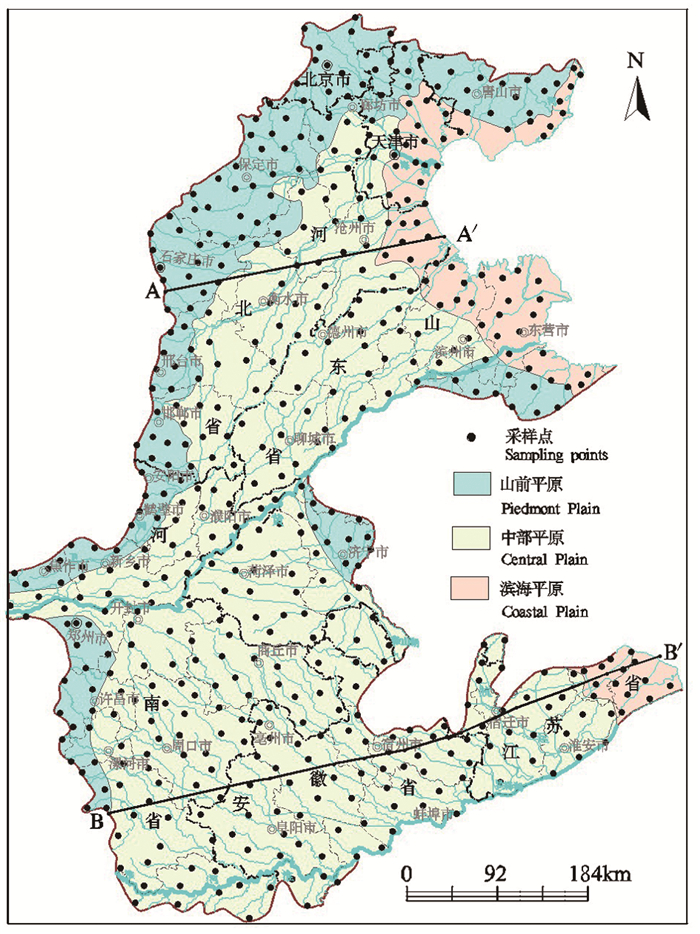
 下载:
下载:
